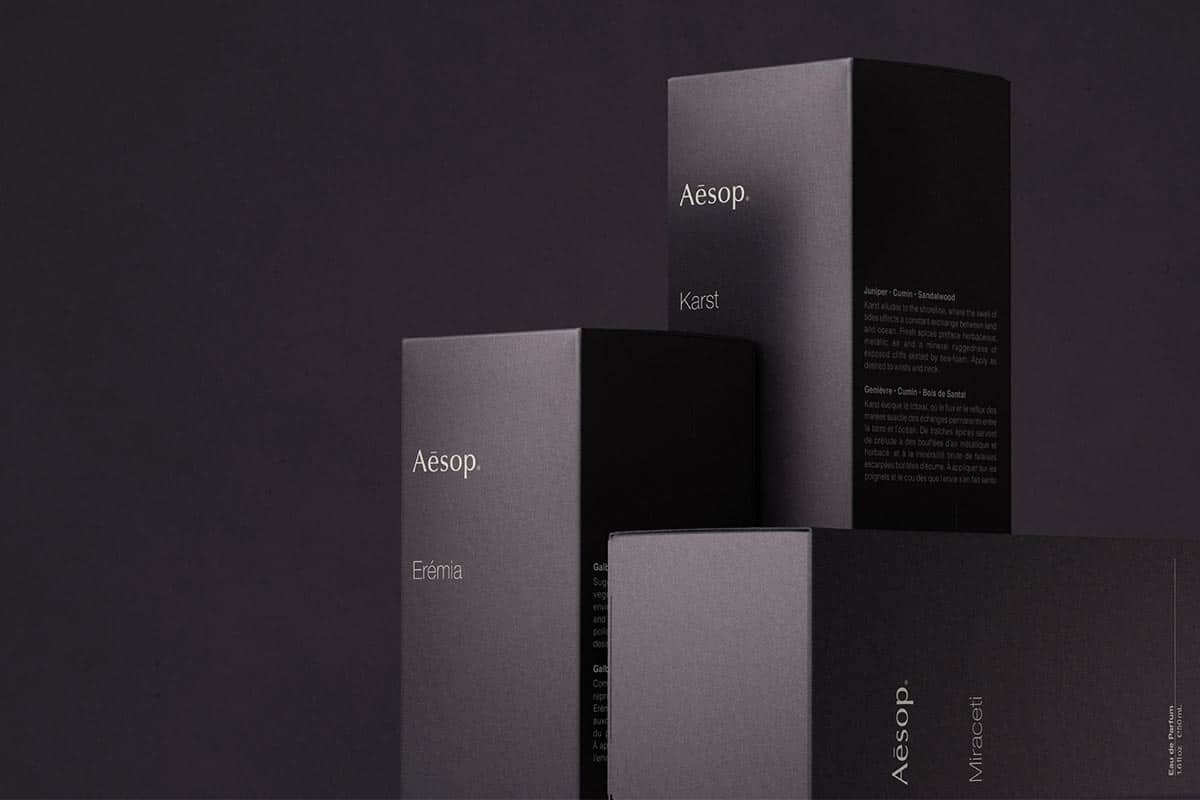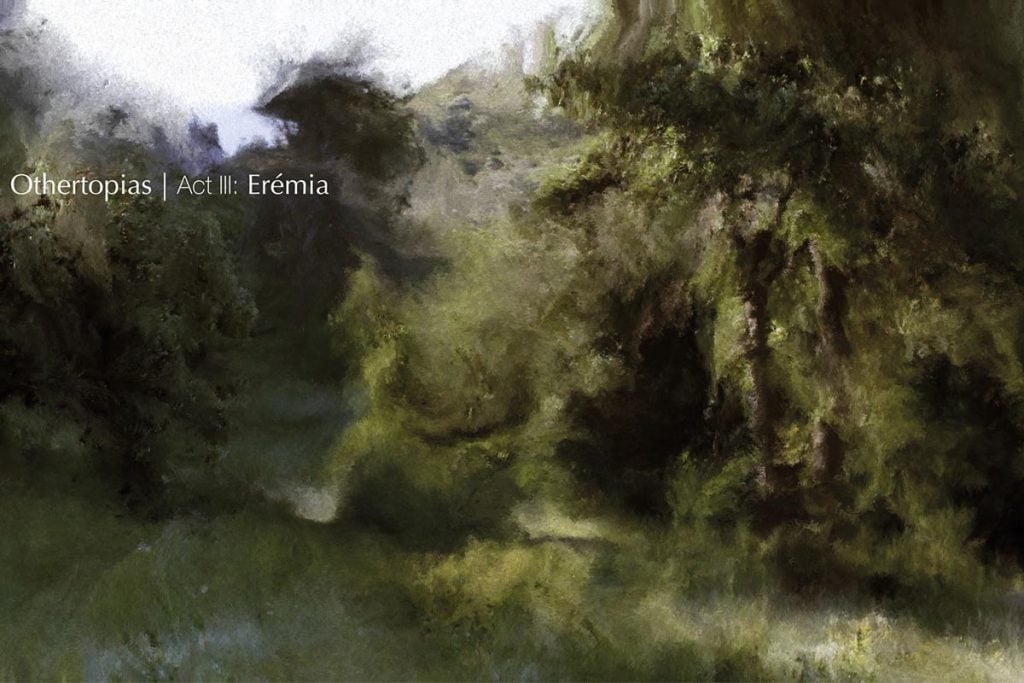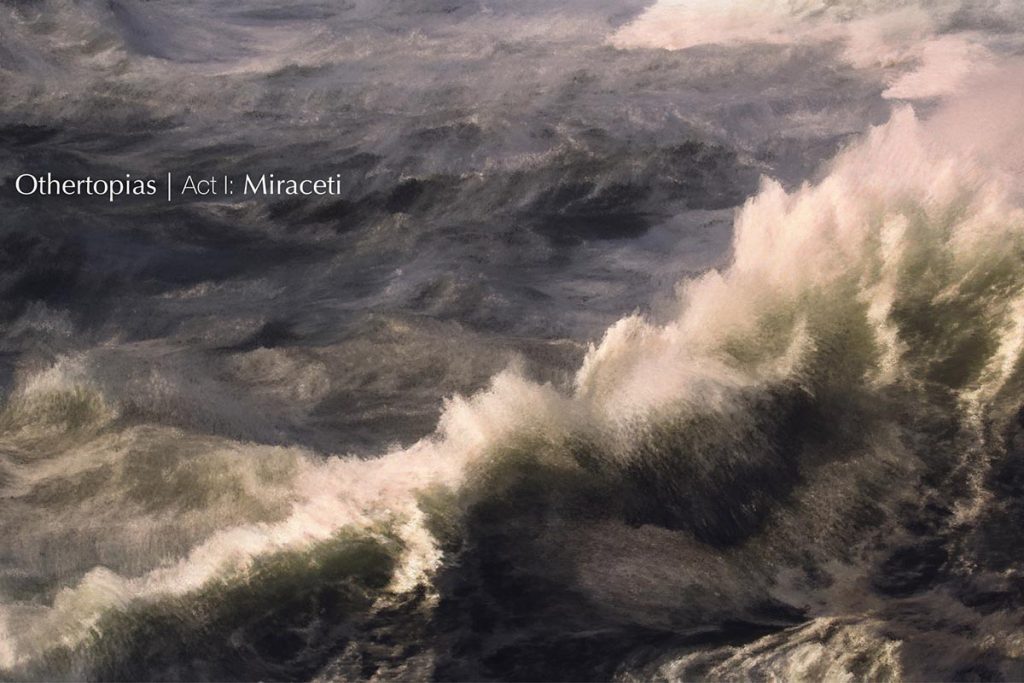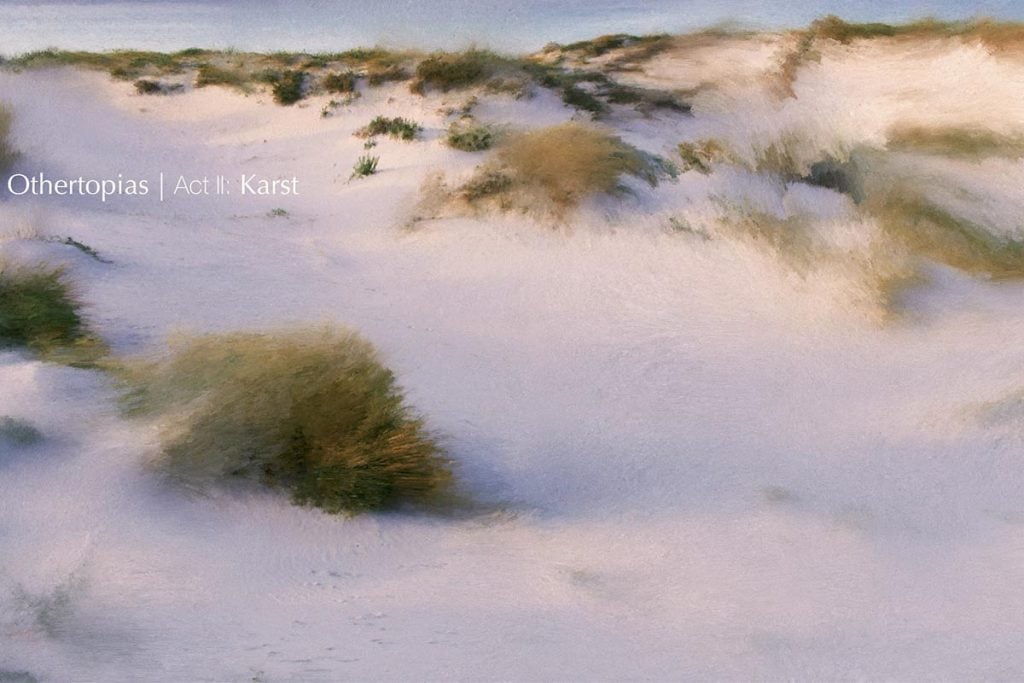
We know scent is one of the most powerful triggers of memory. It was this unique connection that served as the driving force behind Aesop's latest fragrance collection.
A trio of scents, aptly titled Othertopias, these distinct fragrances are each made up of scent triggers that help to paint a picture of another world. Named Miraceti, Karst and Erémia, these three represent the worlds of the boat, the shore and the wasteland. And when you smell them, you can truly begin to build a picture of each place. Miraceti is strong and woody, Karst has a salty tang and Erémia is zesty but deeply earthy, almost mossy.
As with any new Aesop product collection, this one was focused, totally unique and deeply cerebral. To help build the tale, the brand worked with famed perfumer Barnabé Fillion to create these scent stories. Fillion took us through his calculated and yet untamed process for developing this special products, which included using philosophy and his experience with synesthesia to create and redefine the typical olfactory journey.
I wanted to hear first in your own words what was the idea behind this fragrance trio, and what was the name Othertopias inspired by?
So Othertopias is about the concept of collection. It started in 2017, when I collaborated with one of my best friends and we discussed that idea of from different philosophers. We shared this idea with the founder of Aesop, and from this we begin to work on the idea of the perfume collection.
This includes the perfumes Karst, Erémia, Miraceti, and they are all sort of pieces of research on the boundaries between real and imagined. The concept of all of these serve as a footing for the development of these perfumes. They are all an homage to the work of these philosophers. They wrote a lot on the poetic of space and many other thinkers have worked on his idea of space being relative to realities, but allow us to be connected to meteorology, poetry, and have the ability to make us travel and unlock our reverie.
What can we expect from these scents? What are these designed to evoke?
As first, Erémia was inspired by the concept of Greek ‘kora’ which means city. But it’s more than that. It means the city outside of the city. The place where the philosophers were and observing the city. It’s not the place of retreat, but the place of thinking better in relation to nature.
The three perfumes now and the three that will come later to complete the collection are sort of tools to measure the relationship between man and nature. They all explore that relationship.
Erémia is about the city outside of the city, which became sort of a garden - a place where all the seeds and species of the world are kept in beauty. But to make it more modern, we wanted to think of the Yorba Garden, a merging space between the city and its outskirts. We play with the merging and space in-between these two. It’s about the force of the nature taking back life over the concrete of the city.

It manifests the idea of this unstoppable force of nature and the city resisting against that. It’s more of a wasteland: a sort of urban space where nature reclaims itself. I work a lot with the pollenisation and the spreading of the species in the air, things you can’t see so it’s almost poetic, while capturing all the smells of the city itself.
There is the green, fresh citric note that is based on the Uzu as the top note, but then it can smell like the musty side of a city in summer like concrete and dust. Then we have many more ingredients like mimosa, green tea, galbanon, and patchouli.
Miraceti is another level of man and nature. I had a vision from the beginning of an image of the captain from Moby Dick, and it’s rage against nature, the force of will and surety that he would lose, but the inability to admit that nature is stronger than his rage. It’s the chasing of the object, the obscure object of desire, that is manifested as the whale in Moby Dick. It’s the atmosphere of the captain himself; the boat at night; the sea in general and the sails. There was also another book from Edgar Allen Poe that was important for me, it’s called The Gold-Bug. It’s the scene where the main character is a prisoner in a boat, and he’s being forced to lay down with his dog. He’s describing this prisoner situation on the boat where he’s floating in space on the ocean and describing the smells of wood; of whiskeys; of the seaweed. All of this is what I wanted to manifest in the scent.

In general, one iconic ingredient is ambergris. It’s something I don’t touch or work with, as it’s an animal byproduct and we don’t touch that. But it speaks to the purity and the narrative of the oceans. I looked at the documents of the first found ambergris, and they talk about different [characteristics]. From hay to black tea, smoked tobacco, and animalistic complexities found in this one ingredient as a fossil floating on the ocean. I don’t use ambergris, but I do use a lot of things to represent that idea of the ocean in the perfume.
Karst is another that takes inspiration from the landscape. It references two very important places. The first is the shore of our territories, and the relation between the sea and the shore. Every year in a way we lose and win thousands of kilometres of coast. When we lose that, we find fossils; seeds, and elements that help us know more about our past. There’s something very special about this space which contains different times. It’s the relation between the beauty of the sea element and the calcic coast. Friedrich Nietzsche approached perfume and questioned ‘is the most perfect perfume just the smell of pure air?’. So this perfume is about the exploration of what is pure air. What is air, and what is the smell of air?
You say Karst is about the smell of air. I'm curious, what is the smell of air?
Air for me is something unique and herbaceous and obviously marine. I used juniper, Marin, sandalwood. It’s not that I have so many ingredients that represent the signature of the scent, it’s more the little doses of many ingredients that create not a feeling of emptiness, but a void with the relation of the sea with the herbal coast. I don’t like to say so much about Karst because it’s more of an abstraction about he other. The nature of it is more ambiguous, because it’s about just exhaling and inhaling. It’s about the equality of the movements in life, and the exchange between things like the sea and the coast, and when boats go and how the shore is ready to receive it when it comes back again. It’s really like the binary movements like breathing.

How do you want Othertopias to make audiences feel? What should they take from these scents?
We question the position of perfume in philosophy. It has been discarded along with many philosophers as it seems to be just an artificial scent, when it’s actually primal and what guides our progress in the world. We want to guide people to their olfactory perception and observation to reveal another view on the world, transporting them to a world both real and imagined.
We want the user to feel very engaged as to look differently, and ultimately we want to encourage them to imagine. Our sense of smell is accrued and each aroma is informed by our experience, and then shaped by our dreams and memories. The three fragrances are distilling the worlds of the boat, the shore and the wasteland. They are three liminal spaces that challenge perception and invite conversation and reverie.
Where did you get your inspiration for these formulations? You’ve mentioned how each of them has a unique story and a tale behind it, but where did you ultimately start?
We really started with the philosophy research together with my philosopher friend. From there, I shared that to the team that gave some advice on how to continue the research. At some point, we thought about it as a collection, and thought about the definition of it as a collection. We asked how many items should it be and why, and then we went back to our inspiration from the research.
We looked at the work of the writers, historians and philosophers I mentioned, and even the work of Andrei Dhotel. He wrote about how plants are intelligent beings in a surrealist book with an interesting conclusion, where he talks about the state of the flower themselves and looking at our reality like a dream. The flower is dreaming, and their dream is the way we are living, and they are in our world. By having their own consciousness, they see things very different to us.
What I wanted is to enlighten the unstoppable force of the vegetal world against even things like concrete, and the potential consciousness behind all the pollenisation and the unstoppable laws of the seasons and nature.
Is that how you would normally work and conceive a new fragrance? By starting with philosophy, literature and not just an idea of smells?
It has been different for every project. I like to play with synthesists. I have synesthesia so I try to push myself to not just be focussed on one island of the senses. I mostly work with things like a pictorial encyclopaedia where I see texture in images that give me the idea of scents and smell and the idea to use ingredients.
With this I wanted to go more into philosophy but this time was kind of different. I’m more visual, so I usually start with visual elements and then fragrances where I can start to formulate.
What are some of your favourite ingredients to work with?
Ooof! I love ingredients that have a presence in top notes and base. I don’t use so much ingredients that only work as top notes and give you so much brightness and diffusion. I like to play with the complexity. That’s where you have something like bergamot that appears in the heart but also in the base note. It sounds most impossible, but yes it actually works!
I’m intrigued by tricks and innovation on tradition. I typically use traditional ingredients - they are my fabric - but I like to twist them so they are not at the place they are expected.
What is something you think would surprise people about smell and scent?
Hmm…
I think it’s interesting that when you talk about spatial exploration, watch how people can realise how they as a wearer becomes a moveable piece of space. We’re all space inside of space, so it’s interesting to see how people are going to realise and experiment and enter into conversation with this idea of us and ourselves being spaces too all in constant change.
Othertopias are available now on Aesop.com or in stores.



